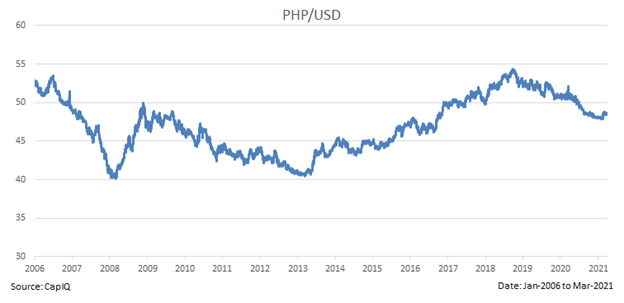MONDAY MACRO: Rising U.S. yields could be good for the Philippine economy if this economic indicator and inflation both stabilize at a favorable rate

In the past weeks, we’ve discussed the rising U.S. treasury yields and investors’ concerns about what that means for the Phlippine stock market and its valuations. As we wait for the latest inflation report this week, we take a look at how inflation could be affected by the higher yields.
Philippine Markets Daily:
The Monday Macro Report
Powered by Valens Research
In our previous Monday Macro report, we talked about how the sudden rise of U.S. treasury yields affected Philippine valuations in 2013. The Philippine Stock Exchange index (PSEi) lost as much as 22% of its value during that period.
While we’re not that concerned about the impact of higher U.S. yields on the local stock market, given the Philippines’ economic and credit fundamentals, there is another metric we should be paying attention to.
Foreign exchange rates are affected by a variety of factors, such as interest rates, inflation rates, political environment, and ease of doing business in a country. Supply and demand, as well as sentiment also play large roles, especially when a particular country is beginning to look more attractive than others.
Generally, investors move their capital to equity or debt instruments that provide the best returns for their preferred investment period. For some investors, that means shifting investments from a low-yielding country to a high-yielding country.
Right now, one of the more attractive high-yielding countries is the U.S.
As the country gets its coronavirus situation under control, the U.S. treasury yields are returning to their 52-week highs, closing at 1.72% on March 30. Investors around the world want to participate in that rise, but in order to do so, they will need to convert their currencies to the U.S. dollar. When demand for the dollar rises, it becomes more valuable and the value of currencies pegged to it, including the Philippine peso, declines.

As of March 30, the exchange rate is at PHP 48.53 for every dollar, a 1.23% dollar appreciation from PHP 47.94 per USD on January 1.
In January, we expected downward pressure on the U.S. dollar to continue in the first quarter. Now that there is growing positive sentiment for economic recovery in the U.S. due to its efficient vaccine rollouts in the past three months, we expect the dollar to maintain its strength versus the Philippine peso.
What does the weaker peso mean for the Philippine economy?
On the bright side, a stronger dollar versus the peso means a higher value of OFW remittances. At historically 10% of the Philippines’ annual GDP, remittances have helped the Philippine economy survive even as neighboring countries experienced recessions, such as in the 1997 Asian Financial Crisis.
Despite the pandemic and exchange rate falling below PHP 50 to USD 1 for the second half of 2020, Filipinos abroad were able to send just 0.8% lower remittances in 2020 compared to 2019. With the U.S. accounting for 40% of these remittances, we can expect higher OFW remittances in 2021 as the dollar appreciates.
However, should the peso continue to weaken against the dollar, investors need to watch out for the impact on inflation.
With the expected inflation rate exceeding their target inflation rate of 2%-4%, the BSP will likely not hesitate to raise the policy rates should inflation be driven by demand rather than supply factors like last month. However, this may become counterproductive for the Philippine economy as higher rates could hamper economic growth with borrowing costs rising as a result.
In the event that interest rates become more aggressive due to the depreciating peso, it may take longer for business profitability and the Philippine economy to recover.
About the Philippine Markets Daily
“The Monday Macro Report”
When just about anyone can post just about anything online, it gets increasingly difficult for an individual investor to sift through the plethora of information available.
Investors need a tool that will help them cut through any biased or misleading information and dive straight into reliable and useful data.
Every Monday, we publish an interesting chart on the Philippine economy and stock market. We highlight data that investors would normally look at, but through the lens of Uniform Accounting, a powerful tool that gets investors closer to understanding the economic reality of firms.
Understanding what kind of market we are in, what leading indicators we should be looking at, and what market expectations are, will make investing a less monumental task than finding a needle in a haystack.
Hope you’ve found this week’s macro chart interesting and insightful.
Stay tuned for next week’s Monday Macro report!
Regards,
Angelica Lim
Research Director
Philippine Markets Daily
Powered by Valens Research
www.valens-research.com




